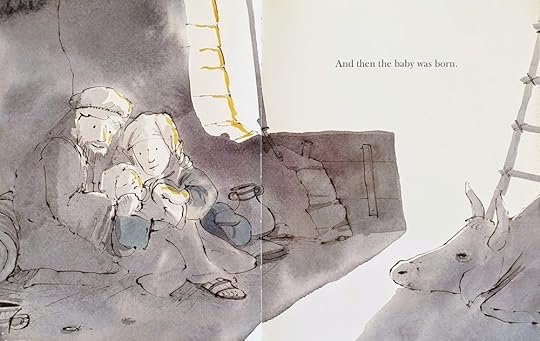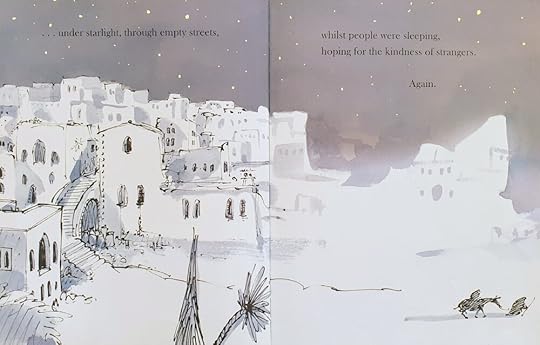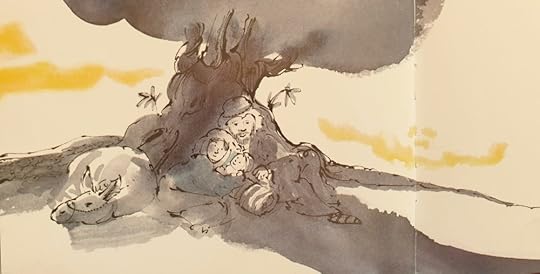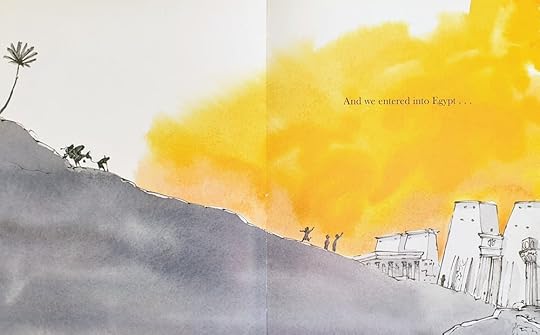Refuge: an important retelling of the Nativity
Goodnight Manger takes a refreshing look at just how noisy and chaotic the traditional tableaux might have been. Meanwhile, in Jesus’ Christmas Party, the focus is on the grumpy innkeeper who is desperate for sleep! Today’s somewhat quieter recommendation looks at the Christmas story from yet another angle – as witnessed by the little donkey: Refuge by Anne Booth, illustrated by Sam Usher (Nosy Crow, 2015)
Booth’s quiet retelling of the Christmas story is faithful to the Biblical account. Yes, it downplays the divine (there are no angels or halos). Instead, Booth focuses on the humanity of the event and, in doing so, brings home truth that is so easily overlooked amid the spectacular drama of angelic hosts and the bright, guiding star. Because when all the trimmings are removed, and you get down to basics, what we’re left with is a vulnerable refugee family. And that’s what this book shines its light on.
The story, narrated by the donkey, begins:
The man led me, and I carried the woman all the way to Bethlehem…
Then promptly jumps to where many nativity stories end:
And then the baby was born.

No fuss.
No heraldic choir of angels.
It’s quiet and intimate – and human.
You can almost hear the rustle of the donkey and the lowing ox.
(Usher’s use of negative space is worth praising – I love how he leaves the white of the paper to convey the bright starlight flooding into the stable.)
Booth’s descriptions of the newborn baby are suitably tender and will resonate with parents (and older siblings) everywhere:
[The woman] smelt his sweet baby breath, and felt his soft, warm baby skin…as he sleepily nuzzled her neck.
Then descriptions remind the reader of the humanity of the scene. Mary, Joseph – and Jesus – were fully human.
They didn’t glow in the dark with holiness.
They huddled close for warmth.
The shepherds come from out of the darkness (shown only as shadowy, indistinct figures), followed by the kings.
When the last king left, the scent of frankincense lingering in the air, we all slept and the man had a dream.
Big chunks of detail have been omitted from Booth’s version of the Nativity. But not this part: Joseph’s dream. It’s usually glossed over, even in church services. Refuge (appropriately) summarises the supernatural encounter as ‘[a] dream of danger’ – and it’s crucial to what happens next.
Here’s the Biblical account:
[A]n angel of the Lord appeared to Joseph in a dream and said, “Get up! Take the Child and His mother and flee to Egypt, and remain there until I tell you; for Herod intends to search for the Child in order to destroy Him.”
…[Herod] sent [soldiers] and put to death all the male children in Bethlehem…who were two years old and under… Then what had been spoken through Jeremiah the prophet was fulfilled:
“A voice was heard in Ramah,
Weeping and great mourning,
Rachel weeping for her children;
She refused to be comforted,
Because they were no more.”’
– Matthew 213-18 (AMP)
The man, the woman and the donkey (now carrying his ‘precious load’) must begin their journey once more. Under cover of night, they flee Bethlehem (and the murderous wrath of King Herod) and head to Egypt where they hope to find ‘the kindness of strangers. Again.’

Travelling through a series of wide vistas, they talk ‘about journeys and dreams and warnings, and the love of a baby, and the kindness of strangers.’ They are small and vulnerable – but hope is conveyed through both words and pictures. Passing shepherds in the fields, there are ‘whispered blessings… the clasp of rough hands, and the love of warm hearts.’
The text is minimal and powerful. Reference to any detail of the danger the family faced is omitted. Still, the reality of their plight is not underplayed. That said, there’s a thread of hope that runs throughout the story.
And when we rested,
And they were frightened,
They took hope from each other,
And from the baby’s tiny first smile.

Young children will read and listen to this story. Therefore, explains Booth, “It must have hope. To be human and not to have hope is to be in hell.”
The hope conveyed through the text is enhanced and emphasised by Usher’s illustrations. The young family’s escape through empty, shadowy streets is illustrated in quiet, grey tones. Here and there are glimmers of hope – hints and highlights of warm yellow and orange, which become more prominent as their journey progresses.
The story concludes with the family entering Egypt. As they find welcome and a safe refuge in the home of strangers, warm, golden yellow floods the page – and holds all the promise of a new dawn.
 ‘[Refuge] is a book with timeless crossover appeal and a message that couldn’t be more relevant,’ wrote the story’s publisher, Nosy Crow, when it was first published in 2015.
‘[Refuge] is a book with timeless crossover appeal and a message that couldn’t be more relevant,’ wrote the story’s publisher, Nosy Crow, when it was first published in 2015. Like Nicola Davies’s The Day War Came, Refuge was created in response to the Syrian and Iraqui refugee crisis.
An inappropriate topic for a child’s picture book?
I guess that depends on how much you value picture books and their significance in a child’s life. Is their sole aim is to entertain and titillate – or if their power is more profound? “[Refuge is an] excellent way to help children make sense of what they are seeing on news bulletins every day,” wrote The Times. I couldn’t agree more, (but I would also add that it’s an excellent tool for developing empathy).
For younger children who may still be sheltered from the realities of life, Refuge is a gently told version of the Nativity (without all the bells and whistles).
For older kids, Refuge (as The Telegraph points out) makes the connection between the familiar Nativity story and today’s refugees ‘fleeing their own King Herod with delicacy and beauty.’
Quality picture books such as Refuge play a crucial role in nurturing our kids. And if we continue developing their sense of empathy, then who knows? Maybe the future will be brighter for refugees and asylum seekers. (After all, our children will grow up to become the decision-makers of tomorrow.)
And maybe displaced children will become a thing of the past.
[image error] STORIES WORTH SHARING: Refuge by Anne Booth, illustrated by Sam Usher(Nosy Crow, 2015)Good to Read for:its message of hopea realistic account of the Christmas storyunderstanding the plight of refugeesText excerpts © 2015 by Anne Booth | Illustrations © 2015 by Sam Usher GOOD TO READPicture books about refugees and asylum seekers• The Day War Came by Nicola Davies and Rebecca Cobb
The Suitcase by Chris Naylor-Ballesteros
King of the Sky by Nicola Davies & Laura Carling
BUY THE BOOKPowered by Bookshop.org
Supporting independent bookshops

“A book with timeless crossover appeal and a message that couldn’t be more relevant.”
–NOSY CROW“A book to share with a lump in your throat and an ache in your heart”
– CHRIS RIDDELL, CHILDREN’S LAUREATE Buy UK BUY US * I EARN COMMISSION FROM THESE LINKS #AD/AFFRELATED ARTICLESSOURCESRefuge by Anne Booth, illustrated by Sam Usher (Nosy Crow, 2015)The Christmas story retold: Refuge – In Pictures (Anne Booth, The Guardian, 13 December 2015)Amplified Bible © The Lockman Foundation© 2021 BY TIM WARNES(UNLESS OTHERWISE ATTRIBUTED)****USE OF THIRD PARTY COPYRIGHTED MATERIAL FALLS UNDER FAIR USE/FAIR DEALING PRACTICE.
My Life in Books
For lovers of kid lit, this memoir - My Life in Books - is intended to give you the confidence and encouragement to share your own passion; to help you make lasting connections through kids’ books.
Originally posted at www.timwarnes.com ...more
- Tim Warnes's profile
- 30 followers



